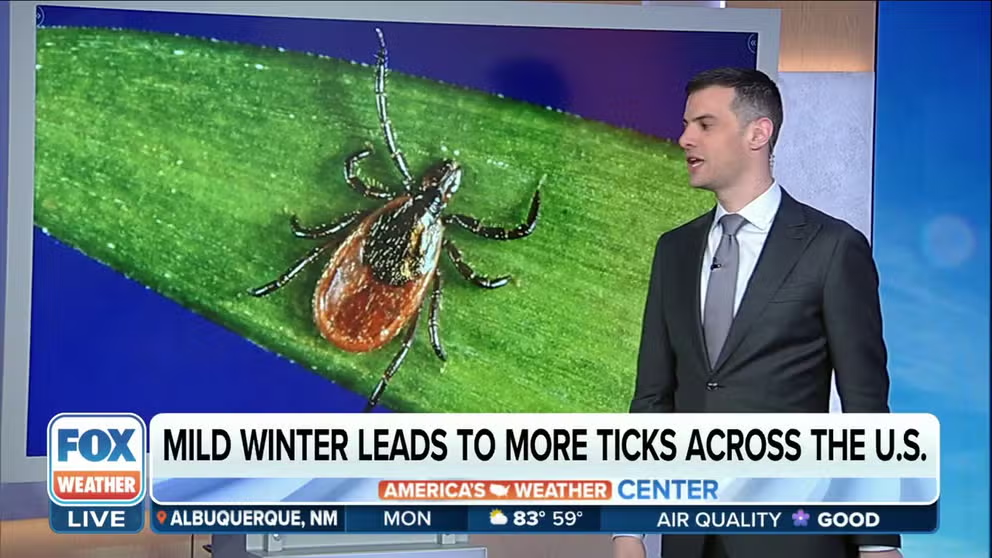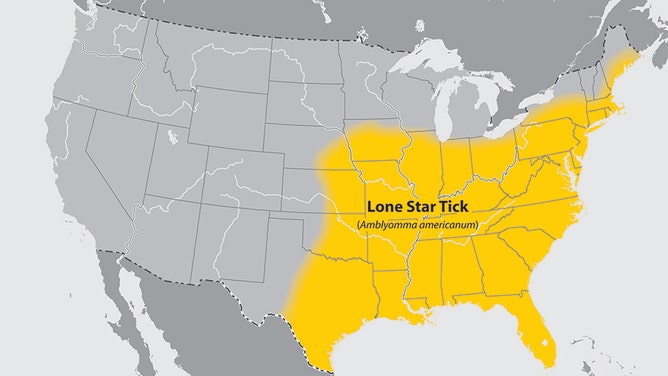Doctors warn of increase in ticks, Lyme disease after mild winter
"We're right in the sweet spot for ticks," warn doctors. The mild winter in the Northeast and the wet winter in the West are leading to excessive tick numbers.
Disease carrying ticks on the rise across the US
"We are really in the sweet spot for ticks," Dr. Purvi Parikh told FOX Weather. The country is in the height of tick season which the doctor fears could be overwhelming after the mild winter. She gives tips on how to avoid debilitating tick borne diseases while out in nature.
Tick season is here, and parts of the U.S. could see a bumper crop. This past mild winter and early spring heat provide the perfect ingredients for an earlier, longer and more active tick season.
"Because of the milder winter, we're seeing many more ticks," said Dr. Purvi Parikh when she sat down with Meteorologist Ian Oliver Monday. "And with the ticks, there are a lot of illnesses to that they carry."

A closeup of a tick.
(Getty Images)
Mild winter means an increase in ticks
Oliver agreed with her saying, "It was more so the winter that wasn't. We didn't really see brutally cold temperatures. We saw almost no snow here in New York City."
New York rewrote the record books this 2023. Weather stations didn't record snow until February 1, the latest in 50 years of records. That marked the second-longest snowless streak for the city as well. Philadelphia, Baltimore and Washington also didn't see snow until February.
NEW YORK CITY FINALLY SEES SNOW WEDNESDAY, ENDING 328-DAY SNOWLESS STREAK
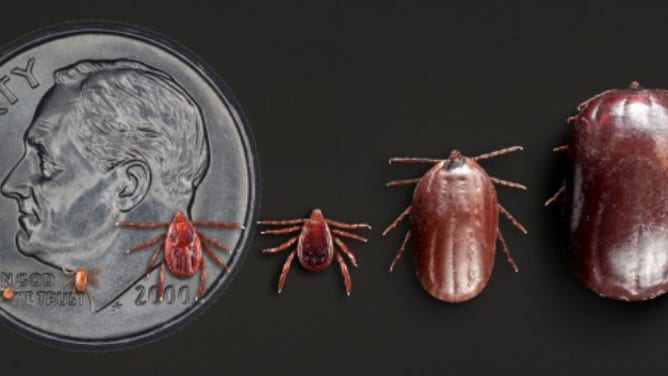
The photo shows the life stages of a brown dog tick. From far left see the larva, nymph, adult male, adult female, partially engorged adult female and engorged adult female.
(Centers for Disease Control and Prevention / FOX Weather)
So ticks escaped the extreme cold that can diminish their numbers, especially in the Northeast.
Disease spreaders
Oliver told FOX Weather viewers that he knows how debilitating tickborne diseases can be. He grew up in Massachusetts and contracted Lyme disease from an infected tick.
"The threat here (is) of ticks carrying a variety of diseases. This is something for me, speaking personally and candidly, Lyme disease, I suffered from it with some serious consequences," he admitted. "Each person in my family, same thing. It is so prevalent now."
And reported cases are increasing every year. U.S. cases of Lyme disease have doubled since 2000, says the CDC.
MALARIA FEARS RISE AS WARMING CLIMATE EXTENDS RANGE OF DISEASE-CARRYING MOSQUITOES, STUDY FINDS

Confirmed and probable Lyme disease cases in the U.S. between 1992 and 2005.
(CDC / FOX Weather)
Lyme disease is the most common tick-borne disease, according to the Centers for Disease Control, and the most commonly reported vector-borne disease (transmitted from animal to human). The CDC estimates that 476,000 Americans were diagnosed and treated for Lyme disease in 2021.
The CDC estimates the cost of the disease for an average patient is $1,200 per infection. Research suggests that it costs the U.S. between $345 million to $968 million every year.
Many more tickborne diseases are just as debilitating. One bite from a lone star tick can cause a life-threatening food allergy to meat. A 3-year-old from Pennsylvania spent weeks in a hospital with a brain infection from a tick.
NEW REASON TO FEAR TICKS: EXTREME FOOD ALLERGY POSSIBLE FROM SINGLE BITE

Johnny spent 12 days in the hospital undergoing multiple tests. He tested positive for Powassan virus, a rare and dangerous tick-borne disease.
(Jamie Simoson / FOX Weather)
"Another one might be Rocky Mountain Spotted Fever, or what we call the spotted group Rickettsia because there's a whole bunch, a slew of tick-borne diseases, frankly, that probably make your eyes glaze over, that physicians know about," Dr. Sarah Park told FOX Weather. "And it's really more important to realize that ticks carry disease, and that could be in any part of the country pretty much."
Ticks love the warm, moist spring, and the CDC shows that emergency room visits for ticks spiked in May and June.
"Depending on the location, 1%-50% of black-legged ticks may have the bacteria," said Amy Korman, Ph.D., Extension Educator with PennSate Extension and entomology expert using Lyme disease as an example.
Enjoy the outdoors; just be aware
Don't fear the outdoors, doctors say. Covering up and doing tick checks can prevent illness. Ticks take hours and days to transmit the disease. For example, a black-legged tick takes 1 to 2 days to transmit bacteria causing Lyme disease.
"So if you live in an area that has predominantly many ticks, that means areas that are very wooded in the Northeast like Massachusetts, Long Island, Connecticut, wooded areas, make sure you're fully covered, especially when you're outdoors and hiking," Parikh continued.
"And that includes socks, long sleeves. And there's also insect repellent spray that you can use as well," she said. "And when you come home, take off all your clothes and check for those ticks because if you catch it early, you can stop the tick before that illness has spread."
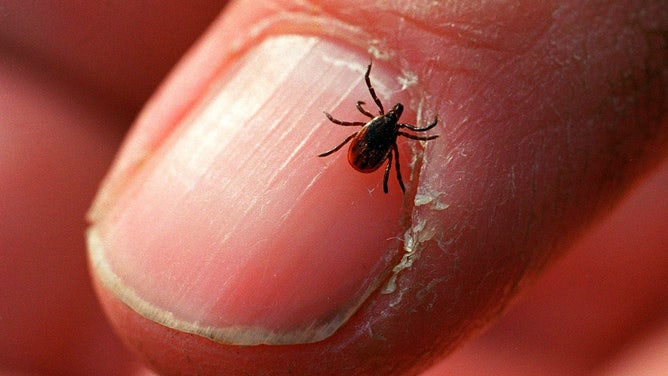
An adult deer tick.
(Photo by Bill Davis/Newsday RM / Getty Images)
"Sometimes you just don't even realize because, as you've noted, the ticks can be really tiny," said Park.
"But if you develop fever, aches and pains, nonspecific kind of people lump it as flu-like symptoms, you should let your doctor know if you know that you've been hiking within maybe the last week or even two weeks you've been outdoors, or you live in an area where you know there's a lot of tick activity," she continued. "Make sure your doctor is aware of that, so they can consider that as they examine you and take into account what might be going on."
Remove a tick from pets and humans
Remove a tick immediately if you find one on your body, advises the CDC. Grasp the tick as close to the head as possible with fine-tipped tweezers and steadily pull. Don’t jerk, twist or crush the tick. Make sure to remove the head from the skin.
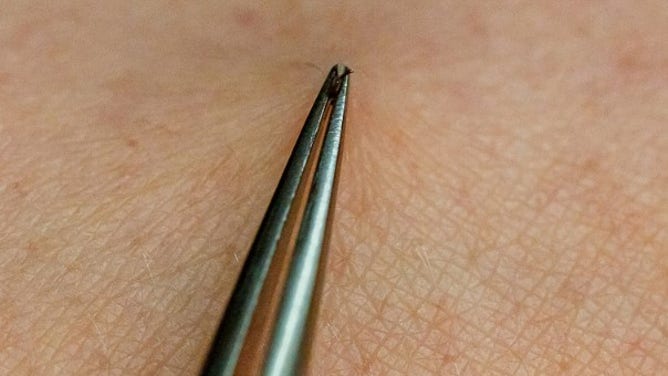
Grasp tick with tweezers as close to head/skin as possible and pull at a steady rate.
(New York State Department of Health/Mike Wren)
Wash the wound and your hands with soap and water or rubbing alcohol. Dispose of the insect by flushing it down the toilet, sealing it in a bag or putting in alcohol before throwing away.
